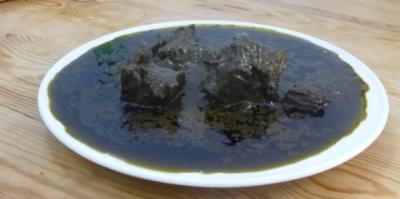
Tracking Down the Elusive Mloukhiya

Tracking Down the Elusive Mloukhiya
Tristan Dreisbach
Having lived in Tunis for over a year, I considered myself well-versed in the country’s diverse culinary landscape. I have conquered the delicate brik, the hearty lablebi, the spicy ojja, and the beloved kafteji.
There was one mysterious food, however, that I long knew only from rumors, the Lochness Monster or Bigfoot of Tunisian cuisine. Other foreign friends would excitedly report the existence of a secret and bizarre dish off-limits to newcomers and rarely found in restaurants.
Luckily, I was finally introduced to mloukhiya by several colleagues, and I quickly fell in love with this odd but endearing dish.
Placed before a novice, mloukhiya may not at first glance or sniff seem the most appetizing meal. It has a very dark green or brown hue and a smell entirely unfamiliar to someone raised on hamburgers and pot roast in the Upper Midwest of the United States. The communal plate will feature a few chunks of either beef or lamb in the middle, but like many staple Tunisian dishes, it is essentially an intensely flavorful sauce.
Put away your spoon or fork when tackling the mloukhiya. The only proper utensil is bread, but beware: one stray drop on your shirt or khakis will take forever to wash out.
So what does it taste like? The basic flavor comes from a bitter plant of the same name used in dishes from the Middle East to West Africa. The Tunisian version is unique in that the plant is first turned into a powder, which is then used to create a thick stew using olive oil, tomato paste, and water. Spices added include coriander, bay leaves, garlic, and harissa, Tunisia’s traditional red pepper paste.
The result is strong, complex, and earthy. It may remind you of other cooked greens, but there is a slightly gritty texture and a distinct aftertaste reminiscent of the kelp you might encounter in Japanese cooking. Some varieties will be a bit spicy.
It is slowly cooked. While around six or seven hours seems the norm, one of my colleagues proudly said that she spends more than 24 hours on hers. Meat is added to the pot when about three hours of cooking time remains.
While it can be eaten any time, the dish is often associated with the Islamic new year, eaten on the first day of the hijri calendar.
A Tunisian household would never cook mloukhiya on a regular basis. It is time-intensive, and it is common to make a very large batch that can be stored in jars and heated up when needed. Preparing the dish is a celebration, a traditional treat from mothers to their families.
It is easy to locate a family preparing the dish. Its distinctive smell wafts into the street, and passersby will find themselves suddenly craving a plate.
http://www.tunisia-live.net/2014/04/03/tracking-down-the-elusive-mloukhi...

Commentaires
Publier un nouveau commentaire